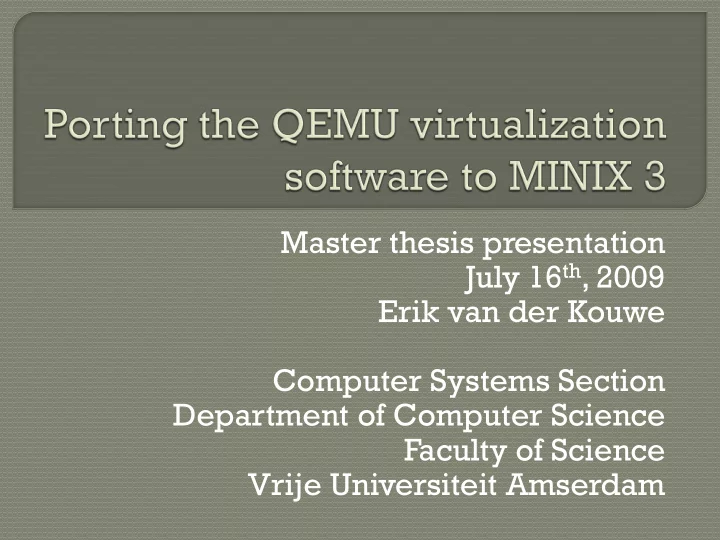

Master thesis presentation July 16 th , 2009 Erik van der Kouwe Computer Systems Section Department of Computer Science Faculty of Science Vrije Universiteit Amserdam
Introduction to virtualization Introduction to QEMU Introduction to MINIX 3 Research questions Porting QEMU Testing QEMU Performance Conclusion
One system emulates one or more VMs • Each runs its own guest operating system • VMs isolated from each other and from host
Uses • Security research • Server farms • Software development Approaches • Native execution Guest code run directly in reproduced environment Sensitive instructions are a problem • Dynamic binary translation Guest code translated into safe host code • Paravirtualization Guest calls hypervisor to avoid sensitive instructions
Open source virtualizer Uses dynamic binary translation • Alternative: direct execution with kernel module Advantages • General purpose full-system virtualization • Portable across hosts and guests • Entirely in user space Disadvantages • Slower than alternatives
Open source OS, built at the VU Microkernel • Reduce amount of high-privilege code Advantages • Simple and structured → suitable for education • Small and reliable → suitable for embedded systems Disadvantages • Few applications and drivers → small community • Many context switches → less performance
Can MINIX 3 run virtualization software? • What issues does one encounter when porting complex software to MINIX 3? • Is it necessary to change MINIX 3 to be able to run QEMU? Is the microkernel design an obstacle for performance? • Can bottlenecks be solved within this design? • Is QEMU usable on MINIX in practice?
Use the right compiler Port packages QEMU depends on Allow QEMU to read MINIX binaries Functionality missing in MINIX • Add if essential for QEMU to work • Avoid using otherwise Debugging
Simply run many operating systems • MINIX (3.1.2a, 3.1.4) • Linux (Debian, Slackware) • Windows (95, 98) And browsers to test networking • Mozilla Firefox • Internet Explorer Findings • Clock resolution is an issue • Performance acceptable for all but Linux
Benchmarks for various activities • Arithmetic, disk, display, interrupts, memory, network, task switching, ... Configurations • Tested with MINIX 3.1.2a and Linux • Both used as host and guest (4 combinations) • Compared with native to find slow-down Overall slow-down just over 10× • Slightly worse than Linux
Bottlenecks in MINIX • Network throughput • Interrupts • Graphics • Disk input/output • Floating point Pauses while sending Setjmp/longjmp No hardware acceleration Small disk cache FPU not supported 0,5 16 1 2 4 8 arithmetic_float arithmetic_int blended_compileminix flow_call flow_conditional flow_exception flow_jumptable flow_syscall flow_taskswitch io_disk_read_random io_disk_read_sequential io_disk_write_random io_disk_write_sequential io_display io_network_latency io_network_throughput memory_load_random memory_load_sequential memory_store_random memory_store_sequential MINIX) ing (emulat Linux ed to compar MINIX down of Slow- Linux) ing (emulat Linux ed to compar MINIX down of Slow-
Yes, MINIX can run QEMU • But modifications are desirable Yes, performance is comparable to Linux • Most bottlenecks are unrelated to microkernel design • But: comparison based on pure binary translation Other results of research • Usable virtualization for MINIX • Manual for porting software to MINIX • List of additions/improvements desirable for MINIX
Recommend
More recommend